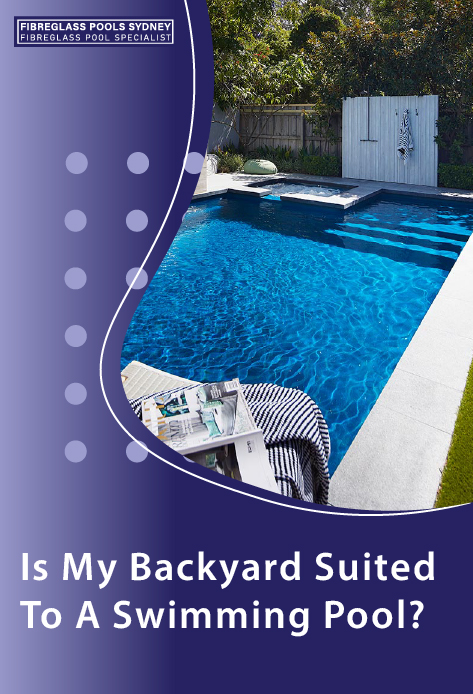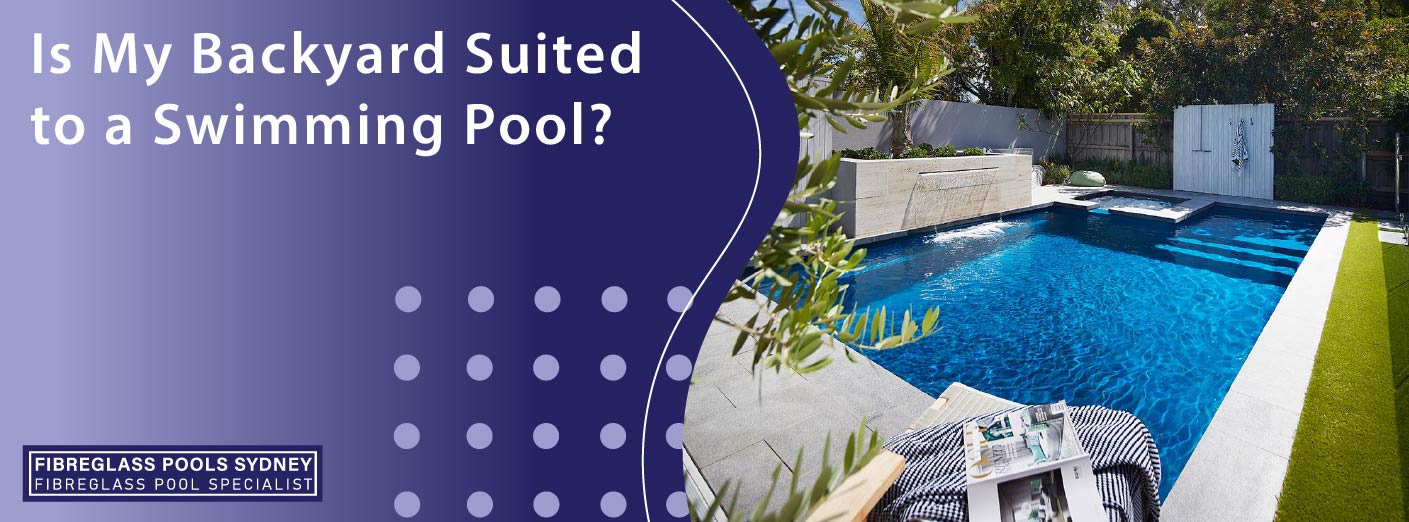Is My Backyard Suited To A Swimming Pool?
A swimming pool has many advantages. Building a swimming pool is an expensive activity that requires long term commitment. Once built, the swimming pool will stay with you for a lifetime. But before you start worrying about the material, landscaping, lighting, and water features, you need to take a good look at your backyard. Not all backyards are suitable for building a pool. Your backyard can make building a pool easy, difficult, or impossible. The following factors related to your backyard can affect the pool building process.

Size Of Your Backyard
If your backyard is large, you can go ahead with any design of your pool. But if your backyard is small or awkwardly shaped, then you will have to be careful while selecting a pool design. Most fibreglass pools are suitable for a variety of backyards. You will also have to determine the area you need for outdoor activities other than swimming. If your swimming pool consumes your entire backyard then there will be no space for your kids to play or for outdoor entertaining.
You will need to have a fair idea about the landscaping required for your pool. Do you require greenery as part of landscaping? Do you need space to lounge around your pool? Do you plan to install an outdoor kitchen, pool shower or elaborate seating near the pool? You need to be clear on all these issues before finalizing the pool design. The size of your backyard will influence these decisions to a great extent.
If there are trees in your backyard, then you need to decide how many trees need to be removed and how many can be retained. Any tree stumps or boulders in your backyard need to be cleared before the start of the pool construction work. You need to determine if any sprinkler system will pose a hindrance in the pool area. Location of any septic system should also be taken into account before finalizing the site of the pool. There needs to sufficient area around the pool for storage areas and decking. Your backyard needs to have comfortable space for the pool, it’s decking, storage, entry and exit points.
Access To Your Backyard
Building a swimming pool involves bringing labor, material and heavy equipment into your backyard. This is especially true if you are building a concrete pool. Your backyard needs to be accessible to this equipment. If the access to your backyard is through a neighbor’s plot then you need to get prior permission from the neighbor.
You need to check if there are any fences, power, utility lines or fences that limit access to pool building equipment. It is best if there is a driveway that gives access to your backyard. Difficulty in gaining access to your backyard can limit the pool construction work considerably. If you are installing a fibreglass pool then you need to get a crane for installation.

Level Of Your Backyard
Swimming pools are easier to build on flat slopes. The construction cost is lower and installation work can be done quickly. If your house is at a steep slope then you may want to go for an above ground pool. Building a swimming pool at a steep slope can be tricky. You will have to choose experienced pool builders. The construction will involve more planning and the costs will be higher.
Quality Of Soil
Soil conditions greatly influence the pool construction process. Your soil condition determines the need for over-excavation, subsurface drainage and even maintenance of your pool. Expansive soil which has the potential to undergo volume changes can damage the pool shell and its piping by causing ground movement. These soil may require solutions like over-excavation, replacing the soil with other materials or laying down deep foundation to support the pool shell in the event of a volume change.
If your backyard has very sandy or soft soil then the sides of the excavation may collapse or degrade. In such backyards, pool wall construction may require formwork or a stainless steel panel and buttress system to support the concrete placement. This may increase construction cost significantly.
If your backyard has any rock ledge then it may require blasting before beginning excavation work.
Your Neighborhood
If your backyard is too close to your neighbor’s house then you may require fencing for privacy. Your pool may be shaded by other buildings or trees in your neighbor’s backyard. If there are trees which extend from your neighbor’s backyard over your pool location then they may drop leaves and dirty the pool. You may want to ask your neighbor to remove those trees.
Property Regulations
In some states, there are strict regulations regarding the distance of the pool from the boundaries, fencing, proximity to stormwater drains etc. You need to find out if your backyard ticks the necessary regulations. It is also necessary to check the location of utilities such as gas, electricity, cable, water and phones in your backyard. There must be enough space to carry out the excavation work without damaging any underground utilities.

Ground Conditions
If your property is located in an area with high water table then installing a pool can be difficult. Subsurface water may come from the water table. There can be surface water infiltration from things such as deck runoff. If water appears on the surface during excavation then pool builders will have to undertake dewatering methods before continuing with the construction work. This can lead to delays and cost escalation.
After installation, if the groundwater level is higher than the lowest point of an inground pool structure then it will exert buoyant forces on the pool shell. If the structure has not been designed to withstand this force then the pool structure may float out of the ground. Sometimes a subsurface drainage system may need to be installed to remove groundwater around the shell. To make matters worse there may be significant groundwater fluctuations in some area. In such cases, the groundwater level should be monitored constantly to prevent problems during construction and maintenance.
Exposure To Sunlight
Your pool requires some sunlight to keep the water warm. It is best to locate your pool in an area which receives sufficient sunlight. If there are too many trees obstructing sunlight then you may need to trim them to clear your pool area.
The Zonal Location Of Your Pool
If your pool is in a flood zone then you may require more approvals for building your pool. You will need a Drainage and Mitigation plans from a civil engineer before you begin construction. An experienced contractor can speed up the process. You will need to build the pool above the floodplain to keep the pool safe. A flooded swimming pool is extremely difficult to clean. Your pool builder may advise you to choose an above ground pool.
You need to do proper homework before starting the pool construction. If you are in doubt then get an expert geotechnical engineer to do site assessment work. Anyone who tells you that a pool can be built in any backyard is lying. Any obstacles due to soil conditions or other factors after starting the construction work will delay the work significantly and also push up the costs. Being prepared beforehand helps you to confidently face any obstacles in your path.
Is My Backyard Suited To A Swimming Pool?
A swimming pool has many advantages. Building a swimming pool is an expensive activity that requires long term commitment. Once built, the swimming pool will stay with you for a lifetime. But before you start worrying about the material, landscaping, lighting, and water features, you need to take a good look at your backyard. Not all backyards are suitable for building a pool. Your backyard can make building a pool easy, difficult, or impossible. The following factors related to your backyard can affect the pool building process.

Size Of Your Backyard
If your backyard is large, you can go ahead with any design of your pool. But if your backyard is small or awkwardly shaped, then you will have to be careful while selecting a pool design. Most fibreglass pools are suitable for a variety of backyards. You will also have to determine the area you need for outdoor activities other than swimming. If your swimming pool consumes your entire backyard then there will be no space for your kids to play or for outdoor entertaining.
You will need to have a fair idea about the landscaping required for your pool. Do you require greenery as part of landscaping? Do you need space to lounge around your pool? Do you plan to install an outdoor kitchen, pool shower or elaborate seating near the pool? You need to be clear on all these issues before finalizing the pool design. The size of your backyard will influence these decisions to a great extent.
If there are trees in your backyard, then you need to decide how many trees need to be removed and how many can be retained. Any tree stumps or boulders in your backyard need to be cleared before the start of the pool construction work. You need to determine if any sprinkler system will pose a hindrance in the pool area. Location of any septic system should also be taken into account before finalizing the site of the pool. There needs to sufficient area around the pool for storage areas and decking. Your backyard needs to have comfortable space for the pool, it’s decking, storage, entry and exit points.
Access To Your Backyard
Building a swimming pool involves bringing labor, material and heavy equipment into your backyard. This is especially true if you are building a concrete pool. Your backyard needs to be accessible to this equipment. If the access to your backyard is through a neighbor’s plot then you need to get prior permission from the neighbor.
You need to check if there are any fences, power, utility lines or fences that limit access to pool building equipment. It is best if there is a driveway that gives access to your backyard. Difficulty in gaining access to your backyard can limit the pool construction work considerably. If you are installing a fibreglass pool then you need to get a crane for installation.

Level Of Your Backyard
Swimming pools are easier to build on flat slopes. The construction cost is lower and installation work can be done quickly. If your house is at a steep slope then you may want to go for an above ground pool. Building a swimming pool at a steep slope can be tricky. You will have to choose experienced pool builders. The construction will involve more planning and the costs will be higher.
Quality Of Soil
Soil conditions greatly influence the pool construction process. Your soil condition determines the need for over-excavation, subsurface drainage and even maintenance of your pool. Expansive soil which has the potential to undergo volume changes can damage the pool shell and its piping by causing ground movement. These soil may require solutions like over-excavation, replacing the soil with other materials or laying down deep foundation to support the pool shell in the event of a volume change.
If your backyard has very sandy or soft soil then the sides of the excavation may collapse or degrade. In such backyards, pool wall construction may require formwork or a stainless steel panel and buttress system to support the concrete placement. This may increase construction cost significantly.
If your backyard has any rock ledge then it may require blasting before beginning excavation work.
Your Neighborhood
If your backyard is too close to your neighbor’s house then you may require fencing for privacy. Your pool may be shaded by other buildings or trees in your neighbor’s backyard. If there are trees which extend from your neighbor’s backyard over your pool location then they may drop leaves and dirty the pool. You may want to ask your neighbor to remove those trees.
Property Regulations
In some states, there are strict regulations regarding the distance of the pool from the boundaries, fencing, proximity to stormwater drains etc. You need to find out if your backyard ticks the necessary regulations. It is also necessary to check the location of utilities such as gas, electricity, cable, water and phones in your backyard. There must be enough space to carry out the excavation work without damaging any underground utilities.

Ground Conditions
If your property is located in an area with high water table then installing a pool can be difficult. Subsurface water may come from the water table. There can be surface water infiltration from things such as deck runoff. If water appears on the surface during excavation then pool builders will have to undertake dewatering methods before continuing with the construction work. This can lead to delays and cost escalation.
After installation, if the groundwater level is higher than the lowest point of an inground pool structure then it will exert buoyant forces on the pool shell. If the structure has not been designed to withstand this force then the pool structure may float out of the ground. Sometimes a subsurface drainage system may need to be installed to remove groundwater around the shell. To make matters worse there may be significant groundwater fluctuations in some area. In such cases, the groundwater level should be monitored constantly to prevent problems during construction and maintenance.
Exposure To Sunlight
Your pool requires some sunlight to keep the water warm. It is best to locate your pool in an area which receives sufficient sunlight. If there are too many trees obstructing sunlight then you may need to trim them to clear your pool area.
The Zonal Location Of Your Pool
If your pool is in a flood zone then you may require more approvals for building your pool. You will need a Drainage and Mitigation plans from a civil engineer before you begin construction. An experienced contractor can speed up the process. You will need to build the pool above the floodplain to keep the pool safe. A flooded swimming pool is extremely difficult to clean. Your pool builder may advise you to choose an above ground pool.
You need to do proper homework before starting the pool construction. If you are in doubt then get an expert geotechnical engineer to do site assessment work. Anyone who tells you that a pool can be built in any backyard is lying. Any obstacles due to soil conditions or other factors after starting the construction work will delay the work significantly and also push up the costs. Being prepared beforehand helps you to confidently face any obstacles in your path.



